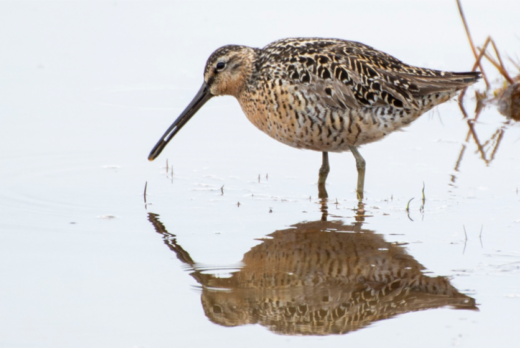Dowitcher Identification in Spring

Distinguishing the two dowitcher species is a notorious challenge for birders, and is made even more difficult by regional variation in subspecies of Short-billed Dowitcher. Here in Alaska, we get the caurinus subspecies of Short-billed, and distinguishing them from Long-billed is relatively straightforward for birds in spring plumage – if you get a good, detailed look at them. Here we’ll go over a few of the key field marks for separating Long-billed and Short-billed Dowitchers in May in Alaska.
Scapular pattern: The scapulars are the back feathers, which rest above the folded wing. Long-billed has a pair of bright white spots at the tip of each scapular, while Short-billed has a longer, thinner, buffier V. This creates a more contrasting barred look on the back of a Long-billed, while a Short-billed looks a bit more muted with an impression of length-wise stripes. The black-and-white barred (Long-billed) versus buffy striped (Short-billed) impression is often apparent even from a distance.
Note that the Short-billed pictured here has also retained some old, faded, worn feathers on the wing, while the Long-billed has not, but that’s not always the case.
Side of the chest: Long-billed has black barring with pale fringes on each feather that are visible at close range. Short-billed has small, discrete black spots (changing into bars as you go back along the flank). The pale fringes on Long-billed wear off over the summer, but are usually present in May. You might also notice that Long-billed has a deeper brick-red background color to the chest, while Short-billed tends to be paler red, but that can be tricky to judge when the birds aren’t side by side.
Primary projection: This refers to how far the primary feathers (solid dark tips of the wing) extend past the tertials (the patterned feathers that rest on top of the primaries when the wing is folded). On Short-billed, the primary tips extend just a little past the tertials:
On Long-billed, the primaries are usually completely hidden by the tertials:
It can be tough to get a good view of this, but this field mark holds true even when the birds are in nonbreeding plumage.
Body shape: While often mentioned in field guides, the difference isn’t consistent and instead depends on temperature, body condition of the birds, and so forth. This can be a good way to initially find candidates for the different species in a mixed flock, but closer study is needed for a definitive identification. The classic difference in body shape is apparent in the next photo: Long-billed looks like a softball with a tail and head tacked on, while Short-billed is more svelte without much of a dip where the tail joins the back.
Bill length: Don’t use it! Bill length differs by sex within species, and a female Short-billed often has a bill just as long as a male Long-billed.
Voice: If you hear them call, their voices are distinctly different: Short-billed gives a “tu-tu-tu” call reminiscent of Lesser Yellowlegs, while Long-billed gives a single sharp “keek!”. The songs are also different: Long-billed sings a sharp, fast, “peeter-weeter-WEETCH-er, “peeter-weeter-WEETCH-er,” where the “WEETCH” note is strongly emphasized on a higher pitch, while Short-billed sings a more mellow, even, somewhat buzzy “peeter-weet-weeter, peeter-weet-weeter.”
Quiz
Test yourself on the next two photos!
Quiz photo 1:
Quiz photo 2:
Scroll down when you’re ready for the answers!
Quiz photo 1:
The scapulars on this bird are a little confusing: at least one feathers has two thicker white spots on it. That could seem to suggest Long-billed, but the spots are still somewhat elongated and are only really present on one feather. The primary projection is also a little hard to judge because some of the tertials are plain and worn rather than showing the typical bright spring colors, but if you look closely, it does look like the primaries extend a bit past the tertials. Finally, and perhaps most definitive on this bird, the side of the chest has small black spots with no sign of white fringes. This is a Short-billed Dowitcher.
Quiz photo 2:
Unlike the above bird, this bird has two bright white spots at the end of most of its scapulars. We can’t judge primary projection here, but the side of the chest is patterned with black bars and white fringes. This is a Long-billed Dowitcher.
Article by: Emily Weiser


